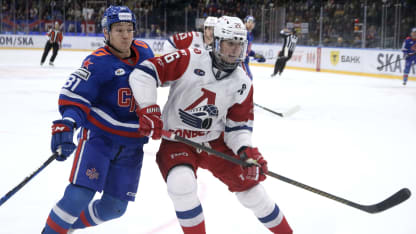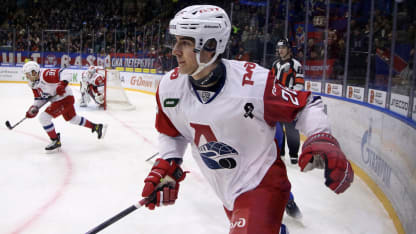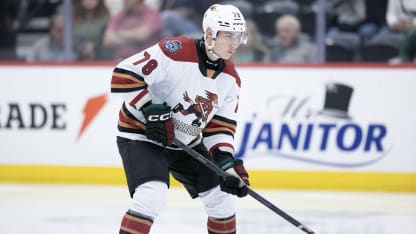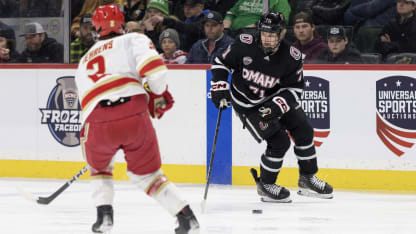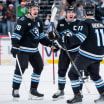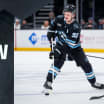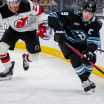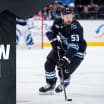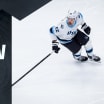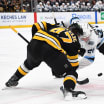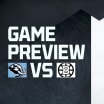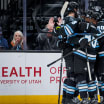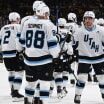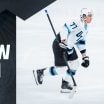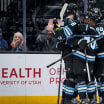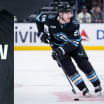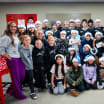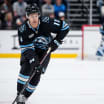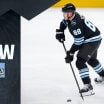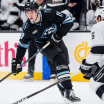Dmitri Simashev
Nothing in Dmitri Simashev's statistics would indicate improved play this season. His ice time has not changed significantly from last season. His point total may not even match last season's total, and there are still nights when the top team in Kontinental Hockey League (KHL), Yaroslavl Lokomotiv, asks Utah Hockey Club's 2023 first-round pick (No. 6 overall) to take a night off as a healthy scratch.
Not to worry. Utah's development staff has been tracking him closely, and there are marked signs of improvement.
"He has improved his puck play and he's showing more drive to add a little more offense to his game," said development coach Kurtis Foster, who works with the organization's defensive prospects. "I just think that he's in a tough spot with a top KHL team that believes in veteran guys so here and there, he has to sit out a game to get some rest. For the most part, it has been a pretty successful year so far."
Utah director of player development Lee Stempniak agreed.
"He's playing a bigger role on a very good team in the KHL and he's getting tougher matchups," Stempniak said. "So even though his ice time is not shooting up dramatically, he's playing tougher minutes which will only help him as he transitions to North America. It's a really positive sign that he's playing tougher matchups, playing on the PK (penalty kill). They're not sheltering him at all, which is a testament to how well he's actually playing."
One of the aspects of Simashev's game that intrigued the scouts and GM Bill Armstrong — aside from his 6-feet-5, 203-pound frame and his excellent skating ability — is how mature Simashev's defensive game is. It's not a stretch to imagine him one day occupying the spot opposite Mikhail Sergachev, even if it means playing his off side.
But Utah's staff still doesn't know how good the offensive side of Simashev's game can become. The curve is still trending upward.
"Last year, there were times when he was bobbling pucks or not cleanly handling pucks and it was leading to turnovers or rush plays against or forced plays," Stempniak said. "He's showing improvement in that area, whether it's his turnovers under pressure or, when he's not pressured, how cleanly he's making plays with the puck on his stick.
"When he gets the puck on his stick, he's able to advance it out of his zone and make those plays. He's more active. He's jumping in as the fourth man on the rush. He's activating in the offensive zone off the blue line. It hasn't resulted in points or goals, but he's getting more touches in the offensive zone. To me, that's the first step. As he gets more touches and he gets confident with the puck, he's going to make more things happen."
The staff got to see some of those skills on display when Simashev played for Russia at the Channel One Cup in December. Russia's coaching staff allowed a more free-wheeling style than Lokomotiv does and Simashev flourished.
"He was able to be more offensive, to carry the puck, to be in the play," Stempniak said. "Just from talking to him, I think that's a part of the game he enjoys and he's comfortable with, and you saw it in his draft year when he was playing in the MHL (Russia's junior league)."
For the time being, Simashev will focus on helping Lokomotiv chase the Gagarin Cup; a trophy the team has never won. Lokomotiv currently leads the KHL with 89 points. The Gagarin Cup Playoffs begin March 26.
"The KHL is a much different game," Foster said. "If they break a puck out and he's the weak-side D, he can join the rush. But I don't find that the D are leading the rush in the KHL. They're more joining the rush. It's almost like a soccer match. It's a possession-based game where if they don't have a play, they'd rather flip it into the neutral zone, get into their structure of their 1-2-2, and almost make teams make mistakes, and then they pounce on their mistakes.
"There will be an adjustment from that when he comes to the NHL, but the message to Dmitri is always, 'Do what your coaches want. We want you playing as much as possible so focus on the team and winning, but work on your offensive game as much as you can in practice and make sure that you're using your feet as much as you can to put yourself in positions to add as much offense as possible.'"
It is possible that Simashev could join Utah Hockey Club as soon as next season with his KHL contract expiring this season. Foster has developed a tight relationship with the prized blue line prospects so he has a good sense of Simashev's mind set.
"He's a lot more open about how he's feeling with me, and how he's playing," Foster said. "He's a very driven kid. He does all the extra stuff after practice and away from the rink. He's focused on his eating and his habits. He wants to play in the NHL and he's made mention that that's his dream. We've got him into a position where I'm hoping he can come over and contribute."

